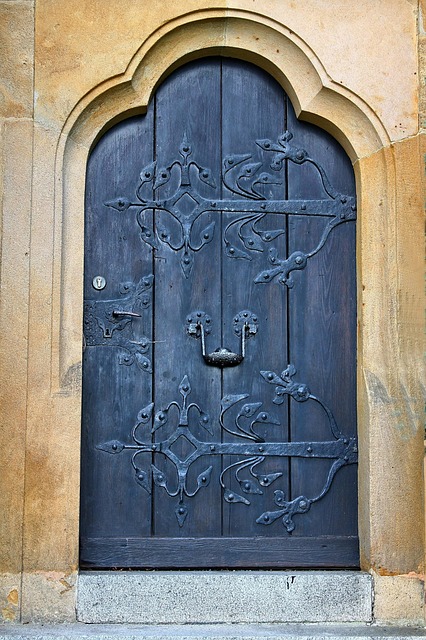Vintage door restoration combines historical preservation with improved energy efficiency. By understanding the door's construction and choosing discreet upgrades like insulated cores and modern weatherstripping, the original aesthetic is maintained while significantly enhancing performance. This process, involving careful assessment, cleaning, and sanding, ensures both functional and visual appeal, blending old and new seamlessly.
In many historic homes, the doors are just as significant as the architecture itself. While they add character and charm, these vintage doors often lack modern energy-saving features. This article explores how to enhance these classic entries with energy-efficient upgrades, such as insulated cores and advanced weatherstripping, without compromising their original aesthetic. We’ll guide you through the process of restoring a vintage door, ensuring both historical preservation and improved energy efficiency.
Understanding Vintage Doors and Their Unique Challenges
Vintage doors, with their charming character and craftsmanship, are a significant part of historic homes’ allure. However, preserving these doors while enhancing energy efficiency presents unique challenges. Many older doors lack modern insulation, making them poor performers in terms of heat retention or cooling. The art of restoration lies in understanding the door’s construction—whether it’s wooden, glass, or a combination—and carefully selecting upgrades that maintain its original aesthetic.
One of the primary considerations is preserving the door’s exterior look to avoid disrupting the home’s overall historical charm. Upgrades like adding insulated cores can significantly improve energy efficiency without altering the door’s visual appeal. Modern weatherstripping, another effective solution, helps seal gaps and prevents drafts while keeping the restoration process discreet. Thus, with careful selection and installation, it’s possible to restore vintage doors to their former glory while making them more energy-efficient.
The Role of Insulated Cores in Energy Efficiency
Vintage door restoration isn’t just about preserving history; it’s also about enhancing energy efficiency. One key component in this endeavor is the addition of insulated cores to historic doors. These cores, often made from materials like foam or fiberglass, serve as a barrier against heat transfer, significantly reducing energy loss and maintaining comfortable indoor temperatures. By encapsulating air pockets, these cores act as an effective insulator, ensuring that cold or hot air remains where it belongs—inside or outside the building, respectively.
This simple yet powerful upgrade is particularly beneficial for older doors, which often lack modern insulation features. Installing insulated cores allows you to maintain the original look and character of your vintage doors while making them more energy-efficient. It’s a practical solution that combines historical preservation with sustainability, contributing to both comfortable living spaces and reduced environmental impact.
Modern Weatherstripping Techniques for Historic Doors
Modern weatherstripping techniques have evolved to cater to both energy efficiency and historical preservation, offering a seamless solution for vintage door restoration. Unlike traditional methods that could mar the exterior, contemporary weatherstrips are designed with precision, allowing them to fit securely behind the door’s trim. These advanced strips create an airtight seal, blocking drafts and preventing moisture intrusion, while their subtle design maintains the authentic look of historic doors.
For example, self-adhesive weatherstrips can be easily installed over existing doors without damaging the original finish. They provide a flexible yet robust barrier, ensuring energy savings without compromising on aesthetics. Similarly, custom-fitted brushes or wipers made from soft materials like neoprene offer an effective seal against harsh weather conditions, preserving the door’s structural integrity and visual charm during vintage door restoration projects.
Preserving Exterior Aesthetics During Upgrades
When undertaking energy-efficient upgrades for historic doors, it’s crucial to balance functionality with preserving the exterior aesthetics. Many vintage door restoration techniques focus on maintaining the original look and feel while enhancing insulation and weatherproofing. For example, adding insulated cores doesn’t have to mean sacrificing historical charm; craftspeople can integrate modern materials seamlessly by using designs that mimic the appearance of traditional construction.
Similarly, modern weatherstripping options come in a variety of styles, allowing for subtle upgrades that enhance energy efficiency without overpowering the door’s historic character. By carefully selecting materials and installation methods, it’s possible to create a harmonious blend of old and new, ensuring both optimal performance and visual appeal.
Step-by-Step Guide to Restoring a Vintage Door
Restoring a vintage door is an art that combines respect for history with modern functionality, allowing you to enhance energy efficiency while keeping the original charm intact. Here’s a straightforward guide to help you achieve this balance:
1. Assess the Door’s Condition: Begin by inspecting the door thoroughly. Check for rot or damage on both sides and assess the integrity of the hinges and hardware. This step is crucial as it determines the extent of restoration needed, from simple repairs to more complex replacements.
2. Clean and Sand the Door: Once you’ve identified any issues, gently clean the door using a mild detergent and a soft brush. After cleaning, sand the surface with fine-grit sandpaper to remove any rough spots or previous coatings, ensuring a smooth base for new materials.
In conclusion, upgrading historic doors with energy efficiency in mind is both feasible and essential for preserving these architectural gems while reducing energy costs. By understanding the unique challenges of vintage doors and employing techniques like insulated cores and modern weatherstripping, homeowners can achieve significant energy savings without compromising the exterior aesthetics. Following the step-by-step guide provided, anyone can successfully restore a vintage door, ensuring both its longevity and its role as an efficient barrier against the elements.
